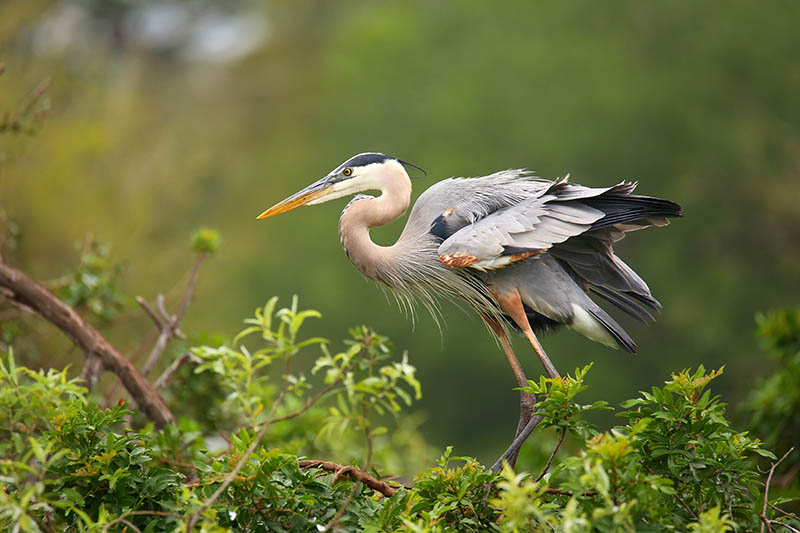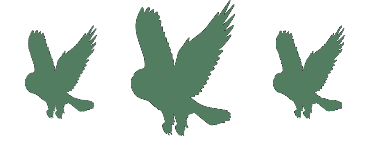What Do Great Blue Herons Eat? Everything You Need to Know!
Last Updated on

Herons are some of the most striking and majestic creatures in our skies, but they’re commonly seen around marshes and swamps. Great blue herons are a larger version of the white heron, living in most parts of North America. As you might expect, they mostly eat fish, but they’re not particularly picky eaters.

About Great Blue Herons
Contrary to the name, great blue herons are closer to a blue-gray than a true blue color. They’re known for their tall, skinny frame, and the unique way their body appears to be an S-shape when flying. Despite their tall height, great blue herons only weigh 5–6 pounds because of their hollow bones.
They have a long, spear-like beak that’s used for fishing. In cold climates, great blue herons have been seen staring at ice fishing holes for hours at a time hunting for prey. They can also swoop from the sky with lightning speed to snag fish out of the water. Their neck vertebrae allow the bird to strike from a surprisingly far distance.
In shallow waters, the great blue heron will slowly wade while patiently waiting for fish. With their keen vision, razor-like beak, and incredible reflexes, the heron can spear even quick-moving fish.
Great blue herons love fish hatcheries, which was initially thought to be a problem for fish farms. However, research discovered that the great blue heron mostly ate the sick, diseased fish that hung around the surface.

What Do Great Blue Herons Eat Besides Fish?
Great blue herons are carnivorous, but unlike some other large birds, they tend to avoid scavenging. Instead, they subsist on a lot of fish as well as other swamp-dwelling critters. They don’t mind eating frogs, amphibians, insects, snakes, rodents, and even small birds. When possible, they’ll also eat small mammals like rodents. However, that’s a rare occasion.
What’s interesting about a diet composed primarily of water-dwelling creatures is that it allows the great blue heron to live for longer than other herons in frozen climates further north.
One of the more interesting things about the great blue heron is its specialized chest feathers. These feathers continuously grow and eventually fray into a powder-like substance that helps the bird clean fish slime off itself. They’ll also brush this powder into their lower parts to protect against swamp grime and oils.

How Do Great Blue Herons Hunt During the Winter?
While most birds will fly south in the winter, great blue herons simply hunker down. They’ll seek out the smallest gaps and holes left in frozen waterways, then guard the holes. If possible, they’ll dive their entire bodies into the hole to snag an unsuspecting fish.
Another interesting tactic great blue herons use to great success is bullying. When ducks and other birds grab fish from deep water herons can’t reach, the great blue heron will seem to attack the duck. After the duck drops the fish, the heron will swoop in and steal it.
Finally, when the weather is simply too bad, herons will seek out other sources of food. You’ll sometimes find the bird stalking deep grasses and reeds in search of small mammals. Mice and voles are particular favorites of the bird during the dead of the winter.

Conclusion
The great blue heron is one of the most beautiful animals you’ll find in North America’s swamps and frozen winter wastelands. With a unique ability to stay still at fishing holes for long periods of time and a body perfectly suited for fishing, the great blue heron will even steal prey from other animals.
Featured Image Credit: Don Mammoser, Shutterstock
About the Author Codee Chessher
Codee Chessher is a freelance writer with extensive knowledge on a variety of subjects that include travel, sound engineering, automotive, optics, DIY, pets, and more. He has a colorful past that includes building schools and commercial driving, but the written word was always his first love and continues to be his passion. He believes there's nothing a well-worded sentence can't accomplish.
Related Articles:
10 Types of Hummingbirds in Arkansas (With Pictures)
8 Types of Hummingbirds in Nebraska (With Pictures)
5 Types of Hummingbirds in Idaho (With Pictures)
3 Types of Hummingbirds in Mississippi (With Pictures)
8 Types of Hummingbirds in Kansas (With Pictures)
5 Types of Hummingbirds in West Virginia (With Pictures)
5 Types of Hummingbirds in Ohio (With Pictures)
Where Do Nuthatches Nest? Nuthatch Nesting Habits Explained
